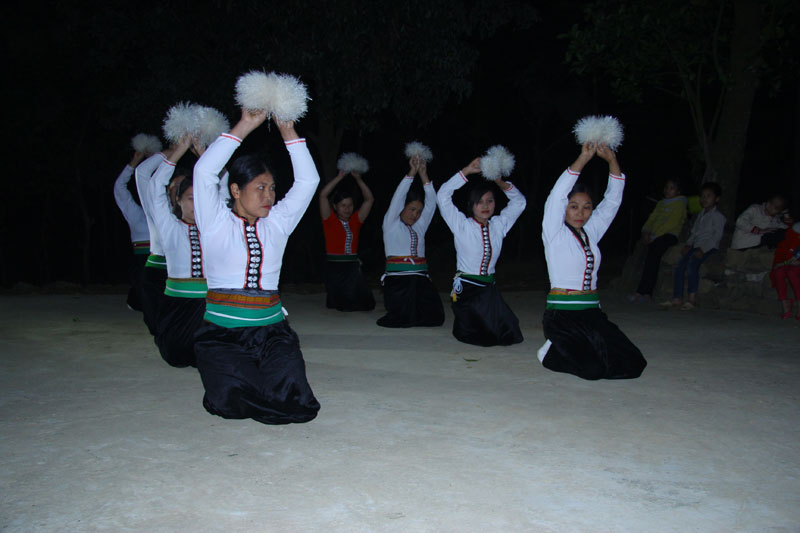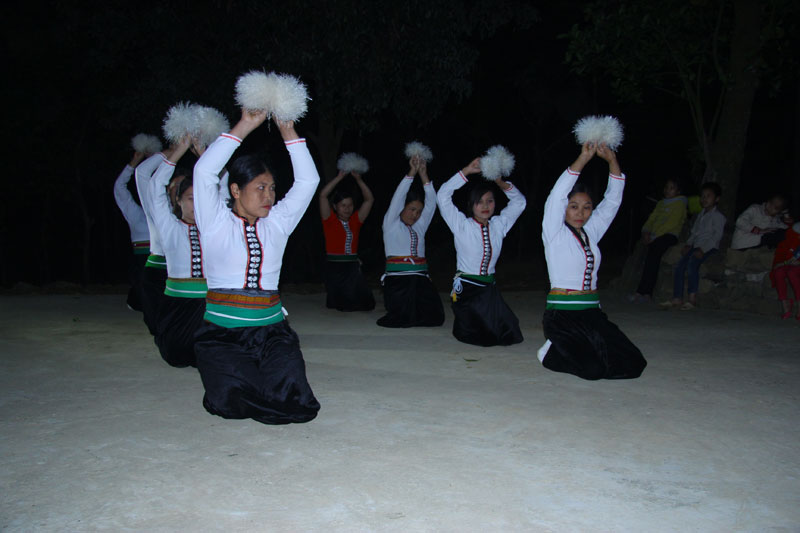
(HBO) - Along with attracting investment in tourism projects around Hoa Binh lake, Hoa Binh province has also paid due attention to training tourism skills for local people in order to create sustainable livelihoods and better their living conditions, said Do Le Phuong, Deputy Head of the Tourism Division under the provincial Department of Culture, Sports and Tourism.

Photo: An amateur art troupe of
Da Bia hamlet, Tien Phong commune (Da Bac district) is performing to serve
tourists
In
2017, the provincial Department of
Culture, Sports and Tourism has joined hands with relevant agencies to work out
a plan to train and improve tourism skills for local people in communes around
the Hoa Binh lake. The department advised the provincial People’s Committee to
call for investors to build tourism products in Hoa Binh lake.
Home-stay tourism skills were provided for 42 households offering community-based
tourism services in Ngoi hamlet (Ngoi Hoa commune), Ke hamlet (Hien Luong
commune) and Da Bia hamlet (Tien Phong commune) through a training course
jointly held by the department and
Hanoi
Tourism
College.
They were equipped with basic home-stay tourism knowledge such as service
quality management, communication skills, tourist serving at accommodations and
food processing. After the training course, the local people were enabled to
take part in fact-finding trips to study the community-based tourism model of
Mong ethnic minority people in Hua Tat village, Moc Chau district, Son La
province.
Dinh Quy Huu, a homestay owner in Ke hamlet, said that: "The training course
brought us useful knowledge to run community tourism. In addition to raising
our awareness of developing tourism while maintaining ethnic identities, it
also encourages us to increase investment in accommodations and improve tourism
product quality to better serve tourists’ demands.”
Following the training course, some households decided to shift from
agricultural production to home-stay tourism business, he said, adding that
three more families will pursue this model in the coming time, bringing the total
number of home-stay service providers in the commune to five.
There
is a substantial increase in the number of visitors to Ke village to experience
the life and culture here, thus helping improve local livelihoods and preserve
cultural values in the commune.
Recently, two professional training courses were organized for 240 people who
are responsible for transporting and serving tourists on ships in Hoa Binh lake.
The trainees were updated basic knowledge and skills on river eco-tourism, Hoa
Binh tourism, tourism regulations, waterway transport law, environmental
protection, communication skills and emergency aid.
The department also conducted surveys at community-based tourism sites to
provide blankets, pillows and loudspeakers for families running home-stay
tourism services as well as amateur art teams in Ngoi Hoa and Hien Luong
communes./.
Le Chung
A diverse chain of eco-tourism and resort destinations concentrated in Hoa Binh city and the districts of Tan Lac, Da Bac, and Luong Son… Along with the launch of several key high-quality resort tourism projects, these developments have reshaped the landscape and enhanced the appeal of Hoa Binh as a travel destination.
Boasting diverse terrain, a mild climate, and rich natural resources, Cao Phong district is increasingly asserting its place on Vietnam’s tourism map, attracting both domestic and foreign visitors. The district is renowned for its stunning landscapes, majestic mountains, a crystal-clear hydropower lake, and the unique cultural identity of local ethnic groups.
With its pristine landscapes, unique cultural heritage of Muong ethnic minority, and an expanding range of visitor experiences, Tan Lac district of Hoa Binh has fast become a captivating destination for both domestic and international tourists.
Until now, Sung village in Cao Son commune, Da Bac district remains the only Dao ethnic community in Hoa Binh province to develop a community-based tourism model. Beyond its untouched natural landscapes, cultural identity serves as the cornerstone attraction for visitors.
Alongside the diverse cultural identities of the Kinh, Muong, Tay, Thai, Dao, and Mong ethnic people, Hoa Binh province is also renowned as the "capital" of the northwestern Vietnamese cuisine, offering unique and distinctive dishes. At festivals, during Lunar New Year (Tet), or on significant family or community occasions, special dishes are prepared, leaving a lasting impression on visitors.
A Phong Linh (Yellow Tabebuia) flower garden in Thang village, Thach Yen commune, Cao Phong district is currently in full bloom, drawing a large number of visitors.



